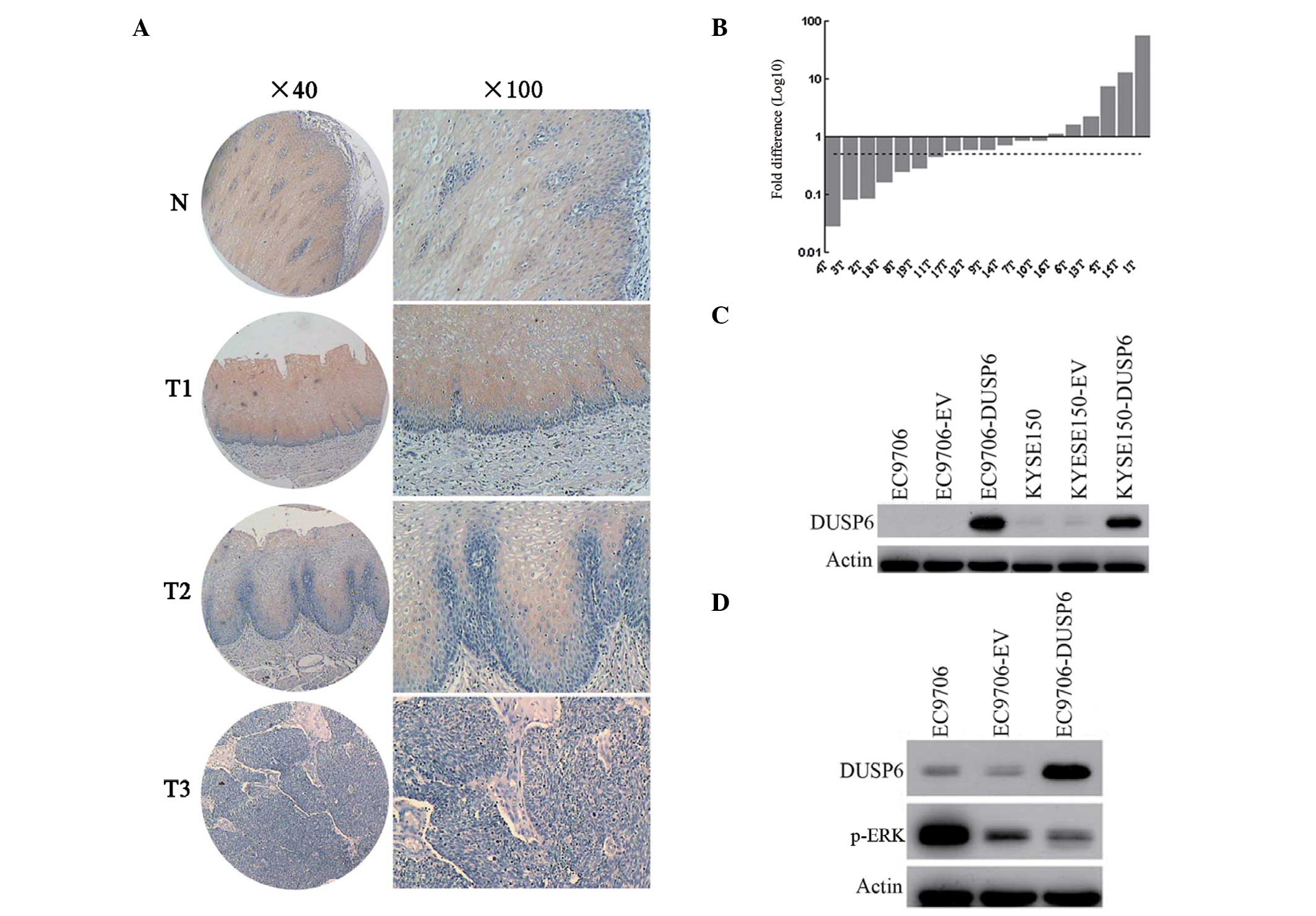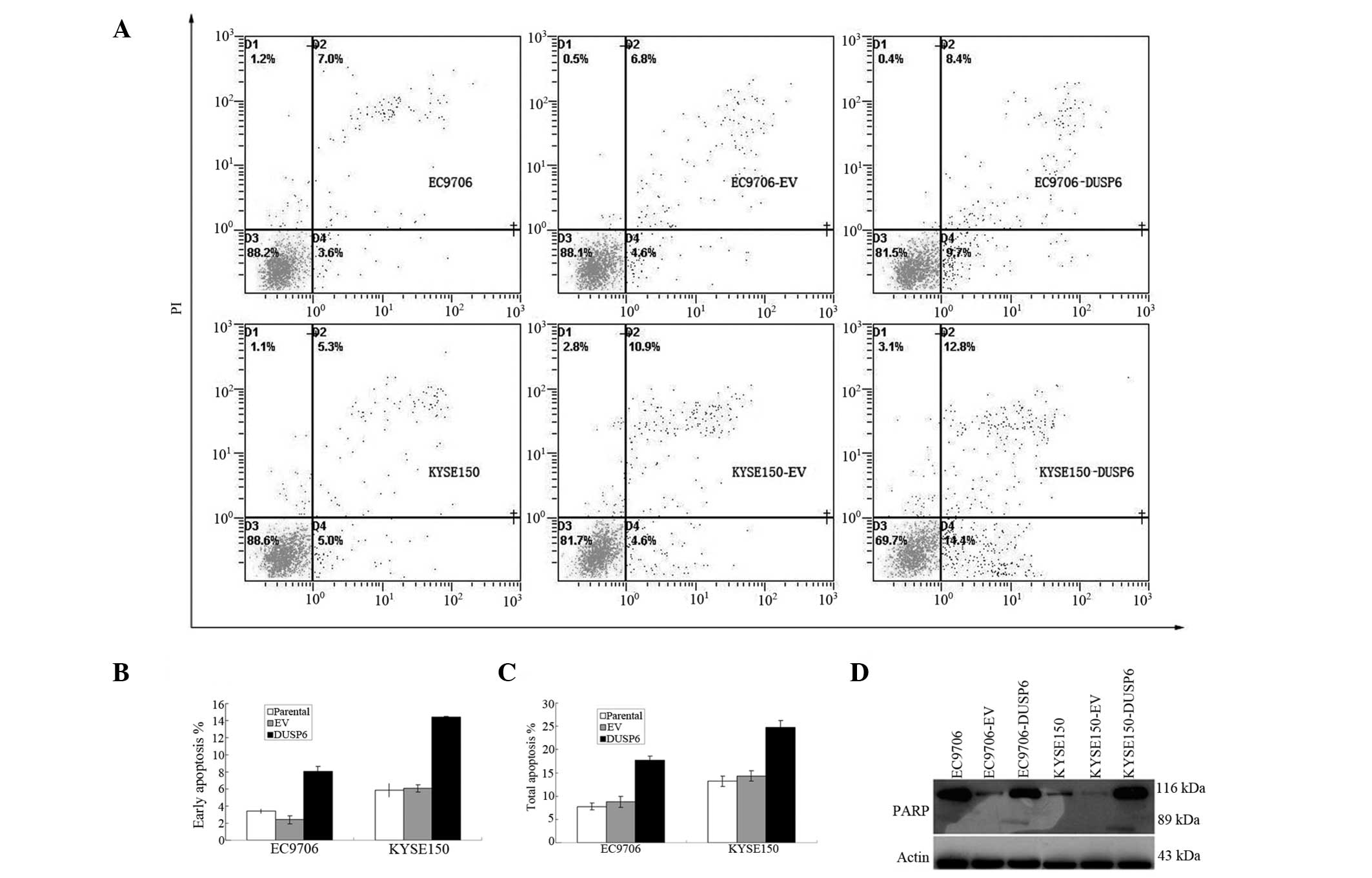|
1
|
Arkell RS, Dickinson RJ, Squires M, Hayat
S, Keyse SM and Cook SJ: DUSP6/MKP-3 inactivates ERK1/2 but fails
to bind and inactivate ERK5. Cell Signal. 20:836–843. 2008.
View Article : Google Scholar : PubMed/NCBI
|
|
2
|
Eblaghie MC, Lunn JS, Dickinson RJ, et al:
Negative feedback regulation of FGF signaling levels by Pyst1/MKP3
in chick embryos. Curr Biol. 13:1009–1018. 2003. View Article : Google Scholar : PubMed/NCBI
|
|
3
|
Lewis TS, Shapiro PS and Ahn NG: Signal
transduction through MAP kinase cascades. Adv Cancer Res.
74:49–139. 1998. View Article : Google Scholar : PubMed/NCBI
|
|
4
|
Chang L and Karin M: Mammalian MAP kinase
signalling cascades. Nature. 410:37–40. 2001. View Article : Google Scholar : PubMed/NCBI
|
|
5
|
Johnson GL and Lapadat R:
Mitogen-activated protein kinase pathways mediated by ERK, JNK, and
p38 protein kinases. Science. 298:1911–1912. 2002. View Article : Google Scholar : PubMed/NCBI
|
|
6
|
Ekerot M, Stavridis MP, Delavaine L, et
al: Negative-feedback regulation of FGF signalling by DUSP6/MKP-3
is driven by ERK1/2 and mediated by Ets factor binding to a
conserved site within the DUSP6/MKP-3 gene promoter. Biochem J.
412:287–298. 2008. View Article : Google Scholar : PubMed/NCBI
|
|
7
|
Nichols A, Camps M, Gillieron C, et al:
Substrate recognition domains within extracellular signal-regulated
kinase mediate binding and catalytic activation of
mitogen-activated protein kinase phosphatase-3. J Biol Chem.
275:24613–24621. 2000. View Article : Google Scholar
|
|
8
|
Muda M, Theodosiou A, Gillieron C, et al:
The mitogen-activated protein kinase phosphatase-3 N-terminal
noncatalytic region is responsible for tight substrate binding and
enzymatic specificity. J Biol Chem. 273:9323–9329. 1998. View Article : Google Scholar
|
|
9
|
Zhou B, Wu L, Shen K, Zhang J, Lawrence DS
and Zhang ZY: Multiple regions of MAP kinase phosphatase 3 are
involved in its recognition and activation by ERK2. J Biol Chem.
276:6506–6515. 2001. View Article : Google Scholar : PubMed/NCBI
|
|
10
|
Sridhar SS, Hedley D and Siu LL: Raf
kinase as a target for anticancer therapeutics. Mol Cancer Ther.
4:677–685. 2005. View Article : Google Scholar : PubMed/NCBI
|
|
11
|
Kohno M and Pouyssegur J: Targeting the
ERK signaling pathway in cancer therapy. Ann Med. 38:200–211. 2006.
View Article : Google Scholar : PubMed/NCBI
|
|
12
|
Furukawa T, Yatsuoka T, Youssef EM, et al:
Genomic analysis of DUSP6, a dual specificity MAP kinase
phosphatase, in pancreatic cancer. Cytogenet Cell Genet.
82:156–159. 1998. View Article : Google Scholar : PubMed/NCBI
|
|
13
|
Furukawa T, Sunamura M, Motoi F, Matsuno S
and Horii A: Potential tumor suppressive pathway involving
DUSP6/MKP-3 in pancreatic cancer. Am J Pathol. 162:1807–1815. 2003.
View Article : Google Scholar : PubMed/NCBI
|
|
14
|
Furukawa T, Fujisaki R, Yoshida Y, et al:
Distinct progression pathways involving the dysfunction of
DUSP6/MKP-3 in pancreatic intraepithelial neoplasia and intraductal
papillary-mucinous neoplasms of the pancreas. Mod Pathol.
18:1034–1042. 2005. View Article : Google Scholar
|
|
15
|
Xu S, Furukawa T, Kanai N, Sunamura M and
Horii A: Abrogation of DUSP6 by hypermethylation in human
pancreatic cancer. J Hum Genet. 50:159–167. 2005. View Article : Google Scholar : PubMed/NCBI
|
|
16
|
Okudela K, Yazawa T, Woo T, et al:
Down-regulation of DUSP6 expression in lung cancer: its mechanism
and potential role in carcinogenesis. Am J Pathol. 175:867–881.
2009. View Article : Google Scholar : PubMed/NCBI
|
|
17
|
Chan DW, Liu VW, Tsao GS, et al: Loss of
MKP3 mediated by oxidative stress enhances tumorigenicity and
chemoresistance of ovarian cancer cells. Carcinogenesis.
29:1742–1750. 2008. View Article : Google Scholar : PubMed/NCBI
|
|
18
|
Croonquist PA, Linden MA, Zhao F and Van
Ness BG: Gene profiling of a myeloma cell line reveals similarities
and unique signatures among IL-6 response, N-ras-activating
mutations, and coculture with bone marrow stromal cells. Blood.
102:2581–2592. 2003. View Article : Google Scholar : PubMed/NCBI
|
|
19
|
Bloethner S, Chen B, Hemminki K, et al:
Effect of common B-RAF and N-RAS mutations on global gene
expression in melanoma cell lines. Carcinogenesis. 26:1224–1232.
2005. View Article : Google Scholar : PubMed/NCBI
|
|
20
|
Ramnarain DB, Park S, Lee DY, et al:
Differential gene expression analysis reveals generation of an
autocrine loop by a mutant epidermal growth factor receptor in
glioma cells. Cancer Res. 66:867–874. 2006. View Article : Google Scholar : PubMed/NCBI
|
|
21
|
Messina S, Frati L, Leonetti C, et al:
Dual-specificity phosphatase DUSP6 has tumor-promoting properties
in human glioblastomas. Oncogene. 30:3813–3820. 2011. View Article : Google Scholar : PubMed/NCBI
|
|
22
|
Warmka JK, Mauro LJ and Wattenberg EV:
Mitogen-activated protein kinase phosphatase-3 is a tumor promoter
target in initiated cells that express oncogenic Ras. J Biol Chem.
279:33085–33092. 2004. View Article : Google Scholar : PubMed/NCBI
|
|
23
|
Cui Y, Parra I, Zhang M, et al: Elevated
expression of mitogen-activated protein kinase phosphatase 3 in
breast tumors: a mechanism of tamoxifen resistance. Cancer Res.
66:5950–5959. 2006. View Article : Google Scholar : PubMed/NCBI
|
|
24
|
Chiappinelli KB, Rimel BJ, Massad LS and
Goodfellow PJ: Infrequent methylation of the DUSP6 phosphatase in
endometrial cancer. Gynecol Oncol. 119:146–150. 2010. View Article : Google Scholar : PubMed/NCBI
|
|
25
|
No authors listed. Esophageal cancer:
epidemiology, pathogenesis and prevention. Nat Clin Pract
Gastroenterol Hepatol. 5:517–526. 2008. View Article : Google Scholar
|
|
26
|
Leung AC, Wong VC, Yang LC, et al:
Frequent decreased expression of candidate tumor suppressor gene,
DEC1, and its anchorage-independent growth properties and impact on
global gene expression in esophageal carcinoma. Int J Cancer.
122:587–594. 2008. View Article : Google Scholar
|
|
27
|
Wang Y, Fan H, Zhou B, et al: Fusion of
human umbilical cord mesenchymal stem cells with esophageal
carcinoma cells inhibits the tumorigenicity of esophageal carcinoma
cells. Int J Oncol. 40:370–377. 2012.PubMed/NCBI
|
|
28
|
Han Y, Wei F, Xu X, et al: Establishment
and comparative genomic hybridization analysis of human esophageal
carcinomas cell line EC9706. Zhonghua Yi Xue Yi Chuan Xue Za Zhi.
19:455–457. 2002.(In Chinese).
|
|
29
|
Shimada Y, Imamura M, Wagata T, Yamaguchi
N and Tobe T: Characterization of 21 newly established esophageal
cancer cell lines. Cancer. 69:277–284. 1992. View Article : Google Scholar : PubMed/NCBI
|
|
30
|
Li LW, Yu XY, Yang Y, Zhang CP, Guo LP and
Lu SH: Expression of esophageal cancer related gene 4 (ECRG4), a
novel tumor suppressor gene, in esophageal cancer and its
inhibitory effect on the tumor growth in vitro and in vivo. Int J
Cancer. 125:1505–1513. 2009. View Article : Google Scholar : PubMed/NCBI
|
|
31
|
Li C, Scott DA, Hatch E, Tian X and
Mansour SL: Dusp6 (Mkp3) is a negative feedback regulator of
FGF-stimulated ERK signaling during mouse development. Development.
134:167–176. 2007. View Article : Google Scholar : PubMed/NCBI
|
|
32
|
Furukawa T and Horii A: Molecular
pathology of pancreatic cancer: in quest of tumor suppressor genes.
Pancreas. 28:253–256. 2004. View Article : Google Scholar : PubMed/NCBI
|
|
33
|
Shimada Y, Sato F, Watanabe G, et al: Loss
of fragile histidine triad gene expression is associated with
progression of esophageal squamous cell carcinoma, but not with the
patient’s prognosis and smoking history. Cancer. 89:5–11. 2000.
|
|
34
|
Zhu YH, Fu L, Chen L, et al:
Downregulation of the novel tumor suppressor DIRAS1 predicts poor
prognosis in esophageal squamous cell carcinoma. Cancer Res.
73:2298–2309. 2013. View Article : Google Scholar : PubMed/NCBI
|
|
35
|
Baylin SB and Ohm JE: Epigenetic gene
silencing in cancer - a mechanism for early oncogenic pathway
addiction? Nat Rev Cancer. 6:107–116. 2006. View Article : Google Scholar : PubMed/NCBI
|
|
36
|
Feinberg AP, Ohlsson R and Henikoff S: The
epigenetic progenitor origin of human cancer. Nat Rev Genet.
7:21–33. 2006. View
Article : Google Scholar : PubMed/NCBI
|
|
37
|
Wong VC, Chen H, Ko JM, et al: Tumor
suppressor dual-specificity phosphatase 6 (DUSP6) impairs cell
invasion and epithelial-mesenchymal transition (EMT)-associated
phenotype. Int J Cancer. 130:83–95. 2012. View Article : Google Scholar : PubMed/NCBI
|
|
38
|
Rössig L, Haendeler J, Hermann C, et al:
Nitric oxide down-regulates MKP-3 mRNA levels: involvement in
endothelial cell protection from apoptosis. J Biol Chem.
275:25502–25507. 2000.PubMed/NCBI
|
|
39
|
Zhang Z, Kobayashi S, Borczuk AC, et al:
Dual specificity phosphatase 6 (DUSP6) is an ETS-regulated negative
feedback mediator of oncogenic ERK signaling in lung cancer cells.
Carcinogenesis. 31:577–586. 2010. View Article : Google Scholar : PubMed/NCBI
|
|
40
|
Le Gall M, Chambard JC, Breittmayer JP,
Grall D, Pouyssegur J and Van Obberghen-Schilling E: The p42/p44
MAP kinase pathway prevents apoptosis induced by anchorage and
serum removal. Mol Biol Cell. 11:1103–1112. 2000.PubMed/NCBI
|
|
41
|
Bonni A, Brunet A, West AE, Datta SR,
Takasu MA and Greenberg ME: Cell survival promoted by the Ras-MAPK
signaling pathway by transcription-dependent and -independent
mechanisms. Science. 286:1358–1362. 1999. View Article : Google Scholar : PubMed/NCBI
|
|
42
|
Erhardt P, Schremser EJ and Cooper GM:
B-Raf inhibits programmed cell death downstream of cytochrome c
release from mitochondria by activating the MEK/Erk pathway. Mol
Cell Biol. 19:5308–5315. 1999.PubMed/NCBI
|
|
43
|
Xia Z, Dickens M, Raingeaud J, Davis RJ
and Greenberg ME: Opposing effects of ERK and JNK-p38 MAP kinases
on apoptosis. Science. 270:1326–1331. 1995. View Article : Google Scholar : PubMed/NCBI
|












